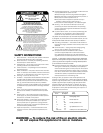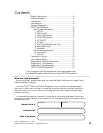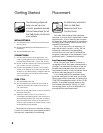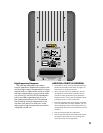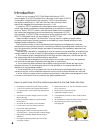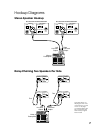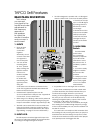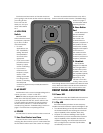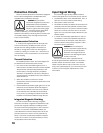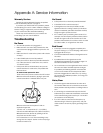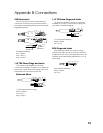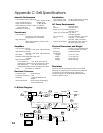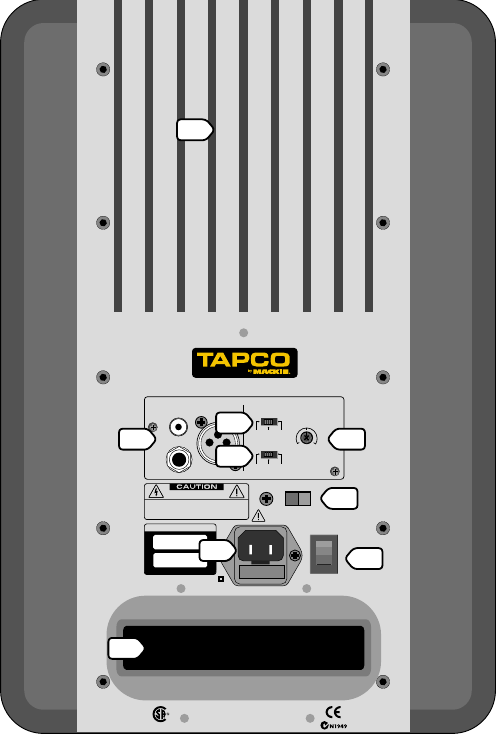
BROUGHT TO YOU BY THE GROOVY FOLKS
IN WOODINVILLE, WASHINGTON, USA
MANUFACTURED IN CHINA
•
FABRIQUE AU CHINE
©2003 MACKIE DESIGNS, INC.
205323
C
US
R
WARNING: TO REDUCE THE RISK OF FIRE OR ELECTRIC SHOCK,
DO NOT EXPOSE THIS EQUIPMENT TO RAIN OR MOISTURE. DO NOT REMOVE COVER.
NO USER SERVICEABLE PARTS INSIDE. REFER SERVICING TO QUALIFIED PERSONNEL.
AVIS : RISQUE DE CHOC ELECTRIQUE — NE PAS OUVRIR
RISK OF ELECTRIC SHOCK
DO NOT OPEN
XLRRCA
INPUTS SETTINGS
LOW FREQ FILTER
HIGH FREQ FILTER
0
(NORMAL)
(BALANCED)
(BALANCED)
(UNBALANCED)
–
2dB
+
2dB
+
2dB0
(NORMAL)
+
4dB
TRS
AC SELECT
S
•
8 ACTIVE STUDIO MONITOR
CAUTION: REPLACE WITH THE SAME FUSE AND RATING.
DISCONNECT SUPPLY CORD BEFORE CHANGING FUSE.
~
220-240VAC = T 800 m A L /250V FUSE
~
100-120VAC = T 1.6 A L / 250V FUSE
ON
SERIAL/DATE CODE
~
100-120VAC/220-240VAC 50-6 0 Hz 110W
INPUT
LEVEL
MAXOFF
115V
8
TAPCO S•8 Features
REAR PANEL
DESCRIPTION
This is where
you connect
your signal to the
monitor and make
adjustments to
the frequency
response of
the speakers
to match the
monitor’s location
and your room’s
environment.
1. INPUTS
• Since all three
of them are
connected
together
electrically, do not
connect more than
one signal at a
time to the jacks.
• You can use the
remaining jacks
as “Thru” jacks for
daisy-chaining the
signal to another
monitor or to
another amplifi er.
If you do this,
be aware that
unbalancing the
signal anywhere
along the
chain does so for all devices connected to the
chain. This negates the benefi ts associated with
balanced lines and inputs.
•
Unbalanced TS (Tip-Sleeve) lines can be
accommodated via the TRS jack. See “Appendix B:
Connections” for more information.
•
When using a TS or TRS plug, make sure it is pushed all
the way into the jack. Partially inserting the plug into
the jack could result in a drop in signal level (by 6 dB).
• The S•8s can be used with a home receiver even
if the receiver lacks a preamp output by using a
speaker-level to line-level attenuator. (See “Input
Signal Wiring” on page 10 for more information.)
2. INPUT LEVEL
The S•8 expects a line-level signal at its input. Use
this control to adjust the sensitivity of the input section
according to the signal strength at its input.
•
The S•8 is designed to operate with a +4 dBu signal
when the INPUT LEVEL control is at the MAX position.
• The S•8 can accept
up to a +20 dBu signal
by turning down the
INPUT LEVEL control
accordingly.
• NEVER connect the
output of an amplifi er
directly to the input
of the S•8. This could
damage the input
circuitry of the studio
monitor.
3. HIGH FREQ
Switch
The HIGH FREQ
switch tailors
the overall high-
frequency response
by ±2 dB at 5 kHz
and above. Leave
this switch in the “0
(NORMAL)” position
unless:
• You want to subtly
brighten or darken
the sound of the
speakers.
• Perhaps you have
hearing loss caused
by too many nights
in front of a double
Marshall stack.
• You just like to mix on the bright side or dull side.
If your mixes consistently sound dull or dark when
you listen elsewhere, this usually indicates that your
monitors are too bright, relative to your normal
hearing. A bit less high-frequency energy usually fi xes
this, and you can force the mix in this direction by
reducing the high-frequency output of the monitors
by using the –2 dB position of the switch.
Conversely, if your mixes are consistently too bright,
then adding some additional high-frequency energy
in the monitors satisfi es your ears, and the resultant mix
has less HF content.
It’s a real rush to mix really loud. But remember that
the resulting mix only sounds good when you play it at
least that loud. However strange it may sound, mixes
made at lower levels sound even better when played
loud, perhaps even a bit bigger than life.
1
2
3
4
5
6
7
8
9




